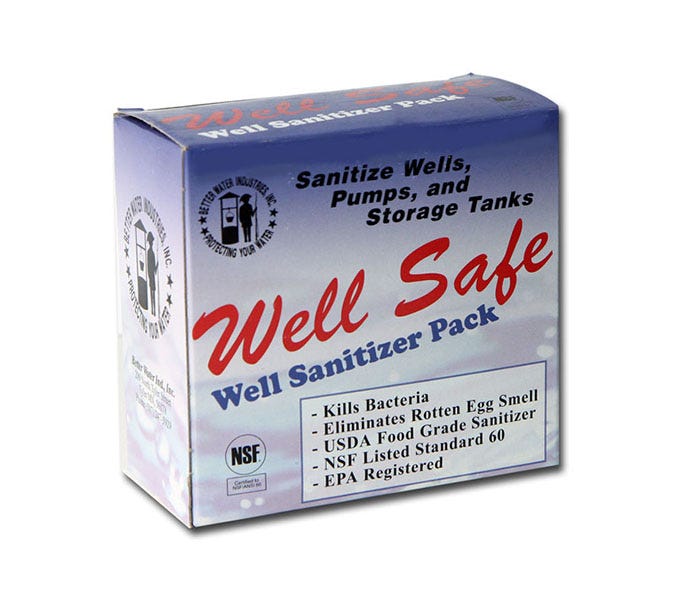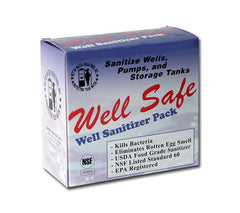SIGN UP FOR OUR NEWSLETTER
Receive our latest updates about our products & promotions.

Save Up to 50% with Factory Direct Pricing
Plus an additional 20% - 25% Off Select Systems!



The 8 oz. container of chlorine pellets is dumped into the well casing where they travel to the bottom and dissolve.
Please note that this product is limited to economy and ground shipping options and cannot be expedited due to Hazmat restrictions. Shipping is also limited to Continental United States only.
Order by 12 PM EST and this system will be on its way the very next day.
Free standard shipping on most products over $199.
Free shipping on most products over $199. Freight orders excluded. Speak to a water expert for more details.
Our Master Water Specialists and Certified Water Specialists review your water analysis and address your specific water problems. WE then design a system that we'll guarantee will solve your water problem(s) and back it with our One-Year Money Back Promise (Guarantee).
It all starts with a Laboratory Test of your water. Then, our Master Water Specialists and Certified Water Specialists will review the results of your water analysis and scientifically discuss the best way to treat your water, provide on estimate of how to do that, and then we provide you a One-Year Guarantee of Satisfaction. It's our Promise to You that our system will do what we say or we will give you your money back*
The 8 oz. container of chlorine pellets is dumped into the well casing where they travel to the bottom and dissolve. The 8 oz. container of chlorine crystals is mixed with 5 gallons of water and dumped into the well casing. It tends to stay towards the top, so that the well is thoroughly sanitized.
Well Safe Pellets are safe, convenient and highly concentrated, providing an effective alternative to the hazards of liquid chlorination. Semi-soft and fast dissolving, Well Sanitizer Pellets are small enough to pass through small restrictions in the well, yet they deliver powerful chemical action that sanitizes the entire water capacity within the well.
Disinfects well water and prolongs the pumps life. Using Well Safe twice a year will help keep wells free from iron and bacteria build-up, improving the smell and taste of the water. A well should be sanitized if it has been contaminated or disturbed as a result of repairs. Well Safe pellets and granules are designed to help purify and eliminate harmful bacteria in storage tanks, well casings, fixtures and pipes.
Disinfection of Drinking Water (Potable Water):
Public Systems:
Mix a ratio of 1 ounce of this product to 6,000 gallons of water. Begin feeding this solution with a hypochlorinator until a free available chlorine residual of at least 0.2 ppm and no more than 0.6 ppm is attained throughout the distribution system. Check water frequently with a chlorine test kit. Bacteriological sampling must be conducted at a frequency no less than that prescribed by the National Primary Drinking Water Regulations. Contact your local Health Department for further details.
Individual Water Systems:
Dug Wells - Upon completion of the casing (lining) wash the interior of the casing (lining) with a 100 ppm available chlorine solution using a stiff brush. This solution can be made by thoroughly mixing 1 ounce of this product into 40 gallons of water. After covering the well, pour the sanitizing solution into the well through both the pipe sleeve opening and the pipeline. Wash the exterior of the pump cylinder also with the sanitizing solution. Start pump and pump water until strong odor of chlorine in water is noted. Stop pump and wait at least 24 hours. After 24 hours flush well until all traces of chlorine have been removed from the water. Contact your local Health Department for further details.
Drilled, Driven & Bored Wells:
Run pump until water is as free from turbidity as possible. Pour a 100 ppm available chlorine sanitizing solution into the well. This solution can be made by thoroughly mixing 1 ounce of this product into 40 gallons of water. Add 5 to 10 gallons of clean, chlorinated water to the well in order to force the sanitizer into the rock formation. Wash the exterior of pump cylinder with the sanitizer. Drop pipeline into well, start pump and pump water until strong odor of chlorine in water is noted. Stop pump and wait at least 24 hours. After 24 hours flush well until all traces of chlorine have been removed from the water. Deep wells with high water levels may necessitate the use of special methods for introduction of the sanitizer into the well. Consult your local Health Department for further details. Flowing Artesian Wells - Artesian wells generally do not require disinfection. If analyses indicate persistent contamination, the well should be disinfected. Consult your local Health Department for further details.
Refer to the product label for Precautionary Statements, First Aid Directions, and Storage and Disposal.
Discounts available for case quantities of 12.
Note: Well sanitizer kits must be shipped via standard ground shipping methods. No expedited options available.
Bypass the water softener, other filters, or purification equipment.Remove the cap or seal from the casing and, if possible, measure the depth of water in the well, then refer to the Table 10 below to
determine how much sanitizer should be used. In some instances removing the seal to measure the water can be a difficult task. It may be easier to estimate well and water depth from well log or other records. As a general rule, it is better to use too much sani- tizer than too little. If too much sanitizer is used, it will simply take longer for the taste and odor to leave the system.
Use a pipe to get by any restriction in the well, a 10’ length of 3/4” PVC is usually ideal. (If it is not possible to remove the well cap, remove vent or sanitation plug.)
Drop one tablet into the well and listen to hear if the tablet hits the water (you will hear a “plink” sound). If the tablet hits the water, drop the remaining determined number of sanitizing tablets needed into the well.
Mix the determined amount of granules needed in a clean, plastic five (5) gallon container of water and pour the solution down the well to sanitize the upper portion of the well. Do not add water to product – Add product to water.
It is necessary to circulate the water in the well to mix the sanitizer thoroughly throughout the entire water system. Connect a hose to an outside silcock that is located after the pressure tank and run water back down the well (this also rinses upper portion of well). After approximately 15 minutes of circulating the water, a strong chlorine odor should be present; if not, repeat steps 4 and 5. Run water through service lines until you detect chlorine odor at all taps.
Allow the sanitized water to stand in the system for at least six (6) hours, although overnight is preferred. Open an outside faucet and flush system until water runs chlorine free (no chlorine smell is detected). Repeat flush operation on each faucet in the system. Do not run high levels of chlorine into septic system.
Note:A) Chlorine may make the water run colored, and iron deposits, slime and organic material may break loose and plug pump screens.
***DO NOT CONTINUE TO RUN PUMP IF WATER DOES NOT FLOW. ***

Receive our latest updates about our products & promotions.
Thanks for subscribing!
This email has been registered!